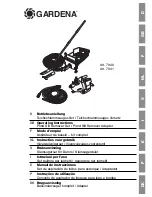
7
Operating information
49
Installation & Operation Manual
General
How the appliance operates
The Copper-fin
2
uses a copper finned tube heat exchanger to
transfer heat from the flue products to the water. An electronic
control module monitors various inputs to initiate a call for
heat. The blower provides both primary and secondary air to
the burner and forces the flue products out of the combustion
chamber and into the vent system. The control module
regulates the blower speed and firing stages, based upon the
heat demand. Gas valves regulate the amount of gas supplied
for the firing stages, which is then mixed with the combustion
air supplied to the burner.
NOTICE
If an inline high gas pressure regulator is
used, it MUST BE of the lockup type and
be located a minimum of 10 feet from
the appliance. Failure to do so may result
in insufficient gas volume supplied to the
appliance.
NOTICE
If a pressure drop of more than 2" water
column occurs between Standby (static)
Mode and Operating (dynamic) Mode, a
gas volume problem exists. Contact the gas
utility, gas supplier, qualified installer, or
service agency to determine the necessary
steps to provide the proper gas volume to
the appliance.
How the control module operates
The SMART SYSTEM control module receives input from
appliance sensors and external devices. The control module
activates and controls the blower and gas valves to regulate heat
input and switches the pool heater and system pumps on and
off as needed. The user programs the module to meet system
needs by adjusting control parameters. These parameters set
operating temperatures and appliance operating modes. Pool
heater operation is based on pool heater return temperature.
Control inputs and outputs
Staging S1 - S4
The S1 input tells the pool heater to provide water for space
heating. The S2 - S4 inputs are not used.
Remote Aquastat/EMS
This input can be used to remotely enable/disable the pool
heater.
Pool heater pump operation
The pool heater’s unit pump will turn on whenever there is a
call for heat based on the set point of the pool return water and
it will remain on as long as the unit is firing. Once set point is
achieved, the pump will complete a purge cycle to remove any
residual heat from the heat exchanger and will then turn off.
Note: If the pump’s pre-running feature is active, the pump
will run for several minutes prior to the unit firing in order
to purge any air from the pool system that may have become
entrapped during extended periods of inactivity.
Pool return programmed as controlling sensor
The pool heater controller is programmed from the factory to
utilize the pool return sensor as the controlling sensor. The
pool return sensor is required to be the controlling sensor and
CANNOT be changed by either the installer or the end user.
Anti-cycling
After the set point has been satisfied, the control will delay the
next burner cycle for a set time period (time is adjustable by the
installer). The time delay will be bypassed if the system return
temperature drops too far during the delay.
Firing rate
Depending upon the model, the Copper-fin
2
is capable of
staging its firing rate from a minimum of 25% to a maximum
of 100%. The firing rate is dictated by the call for heat (i.e.,
pool return temperature), the heating load, and various other
temperature limitations.
Gradient limiting
If during operation of the heater the outlet water temperature
is rising too quickly, the control will reduce the firing rate to
its lowest setting.
Night setback
The controller may be programmed to reduce the set point
during a certain time each day. A start and stop time can be
programmed for each day of the week.
Protection features
Outlet temperature, and temperature rise limiting
The outlet temperature is monitored by the pool heater outlet
temperature sensor. When the outlet temperature exceeds
180°F (82°C), the unit will reduce the firing rate. If the outlet
water temperature exceeds 200° (93°C) the control will shut the
unit down until it cools off.
Summary of Contents for Cooper-fin 2
Page 66: ...66 Notes ...
Page 67: ...67 Notes ...
















































